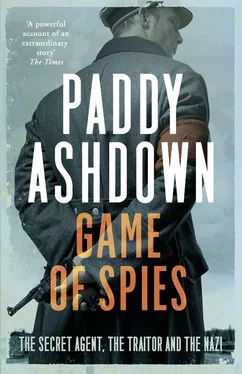The role of organisations such as the Gestapo in the story of the European resistance movements remains, on the other hand, a monochrome black. Little has been written in popular form about how the Gestapo worked, how it fitted into the German hierarchy and especially about the individuals involved. In the popular imagination, Klaus Barbie – the ‘Butcher of Lyon’ – is the model for a Gestapo officer, and it is assumed they were all more or less like that. But of course they weren’t. It is time for a much more rounded description of what life was like then, not just for the secret agent operating in enemy territory, but also for the German security apparatus dealing with this so-called ‘terrorist’ threat, bearing in mind that in our age too we are faced with challenges which are, in practical terms even if not in moral ones, not totally dissimilar.
Following up on the leads in the Aristide archives, we stumbled across the fact that Friedrich Dohse, a Gestapo counter-espionage officer in Bordeaux, had written his memoirs (the only such ones in existence, I believe). These covered the period when his overriding priority was to catch British SOE agent Roger Landes. The opportunity now presented itself to write something which gave both sides of the story.
The third person in the triumvirate at the heart of this book is André Grandclément. He was responsible for one of the most controversial betrayals in wartime France. Much has been written on him, but little about his psychology and the deeper reasons for his ‘betrayal’ (if that, indeed, is what it was).
In this book I hope to give a picture of those times seen through the eyes of these three men – three enemies – who all lived and operated in wartime southwest France. In these pages, I trace their lives, almost on a day-to-day basis, over the two and a half years from the early months of 1942 to the final liberation of Bordeaux in August 1944.
This is not a book of moral judgements. The three men’s stories are presented, as far as possible, plain and unvarnished. Ultimately it is up to the reader to judge what to make of them. But if in the process of making those judgements, a more complete and detailed picture of this fascinating period and of some of the people who lived in it emerges, then this book will have achieved its purpose.
This is a work of non-fiction, based chiefly on primary historical sources. The key details of the story remain disputed even today. With very few exceptions the accounts which form the basis of this work were written shortly after the war, and often by participants whose reputations were at risk – either because they faced accusations of collaboration, or because they were subject to legal action. For instance, a principal source in this book is the unpublished memoirs of Friedrich Dohse, written while he was awaiting trial by a French military tribunal in Bordeaux after the war. These were plainly designed to put the Gestapo officer’s wartime activities in the most favourable light and form part of his defence against the charges he was facing. The same caveat must also apply to the descriptions of events given by others who, while not necessarily preparing for formal court cases, were nevertheless explaining their actions before the court of post-war French public opinion, or simply leaving a record for posterity. There are, in consequence, often radically different versions of the same event. In these cases, difficult judgements of historical evaluation have had to be made. Where an account exists which is substantially different to the one used in this narrative, this fact has been identified in the endnotes.
Sometimes it has been necessary to include some minor speculation in the narrative, where the basic facts surrounding an event have been already established. For example, on 24 September 1943, André Grandclément rode a bicycle through Bordeaux to pay a clandestine visit to the house of Charles Corbin. A visit to the Corbin house for research revealed that the building is very small with a tiny back garden and no back access. Based on these facts and bearing in mind that Grandclément was paying a secret visit to the Corbin family, it seems reasonable to speculate that his bicycle would have been wheeled through the Corbin house into the back garden, rather than leaving it outside.
The dialogue in the Prologue has been reconstructed in a manner consistent with the known facts of the event described. On all other occasions dialogue has only been included where it was either recorded at the time, recorded later by one of the protagonists, or subsequently verified as an accurate representation of what was said.
There are also some important issues regarding terminology. The term ‘Gestapo’ originates from the first letters of the three words used for the Nazi state secret police (GEheimeSTAatsPOlizei). But the ‘true’ Gestapo was only a small element within the overall, highly complex German state security apparatus. However, the Gestapo gained such a reputation during the war that very soon (and with the active encouragement of SOE) the word ‘Gestapo’ became a generic word used to cover all parts of the German security system. In an attempt not to test the sanity of the reader too far with unnecessary complexity, the term ‘Gestapo’ in this narrative is, in almost all cases, used in its wider more ‘popular’ sense, rather than its narrower more technical one.
In the 1930s and 1940s the term ‘spy’ carried pejorative overtones of cheating and underhand activity which it does not have today. For this reason – and perhaps also in the vain hope that their operatives behind enemy lines might gain some flimsy protection from the Geneva Convention provision that spies could be shot – the Special Operations Executive was very particular not to call its operatives ‘spies’, but ‘secret agents’. However, any such distinction was rejected by the German authorities at the time: they ignored SOE’s terminological niceties and treated all their captured agents as spies, liable to immediate execution.
In addition to one or more false identities with which every SOE agent was equipped, each also had a number of aliases or codenames: one which was used under training, another for SOE files and correspondence, and a third for when they were in the field. For example, Roger Landes’s false identities in France were ‘René Pol’ on his first mission and ‘Roger Lalande’ on his second. Under training he was known to his colleagues as ‘Robert Lang’; the internal alias by which he was referred to in SOE papers was ‘Actor’ (all F-Section agents had internal aliases based on occupations) and the nom de guerre by which he was known to his French colleagues was ‘Stanislas’ on his first mission and ‘Aristide’ on his second. In addition, SOE agents often accumulated nicknames while in France: Victor Charles Hayes, codename ‘Printer’, alias ‘Yves’, was more frequently known to his French colleagues as ‘Charlot’ – or, because of his prowess with explosives, ‘Charles le Démolisseur’. Although almost all the participants in this story would have used their aliases when communicating with each other I have used personal names throughout, except where the needs of the story dictate otherwise (for example, when it is appropriate to refer to Roger Landes by the noms de guerre by which he was known to the Gestapo officer Friedrich Dohse – that is, ‘Stanislas’, and later ‘Aristide’).
During the war, the French resistance, diverse and diffuse as it was, was neither referred to nor seen as a single body. It was only after the war that the disparate resistance organisations were regarded as part of a single overarching structure known as the French Resistance (with capitals applied to both words). For ease of reading, I have, in this book, adopted the post-war habit of referring to the French Resistance (with capitals) when referring to the overall organisation, and French resistance when the noun is employed more generally. Latitude and longitude for places of key importance (such as parachute sites and places of execution) are included in the endnotes. For certain military operations, timings are given according to the twenty-four-hour clock and have been converted into Central European Time (Greenwich Mean Time plus one hour from 16 August to 3 April, and GMT plus two hours from 4 April to 15 August) – which was the standard time used throughout all Nazi-occupied Western Europe for the duration of the war.
Читать дальше












